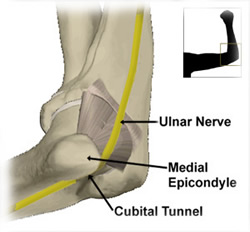Chronic funny bone discomfort is no fun at all
The ''funny bone'' that packs a stinging punch after just a simple bump is actually a nerve and not a bone at all. Spanning from the upper arm alongside the…

Update your location to show providers, locations, and services closest to you.
 The hand has several nerves that supply sensation and movement. The two main nerves of the hand are the median and ulnar nerves. Nerve roots from the spinal cord come together in the axilla to make the brachial plexus, which then splits into many nerves, one of which is the ulnar nerve. The ulnar nerve innervates muscles in the forearm and hand, and gives sensation to parts of the hand. As the ulnar nerve travels to the hand from the arm, it passes through the elbow. The ulnar nerve rests in the condylar groove of the cubital tunnel (the elbow joint) and can be compressed for several reasons.
It is subject to external compression and repetitive minor impacts. The nerve can be compressed from scarring of the ligament over the cubital tunnel. Flexion of the elbow stretches the nerve, which also increases pressure. If the nerve gets entrapped in this area, it can cause numbness and tingling in the palm, ring finger, and small finger. This is called an cubital tunnel syndrome syndrome, or ulnar neuropathy.
The hand has several nerves that supply sensation and movement. The two main nerves of the hand are the median and ulnar nerves. Nerve roots from the spinal cord come together in the axilla to make the brachial plexus, which then splits into many nerves, one of which is the ulnar nerve. The ulnar nerve innervates muscles in the forearm and hand, and gives sensation to parts of the hand. As the ulnar nerve travels to the hand from the arm, it passes through the elbow. The ulnar nerve rests in the condylar groove of the cubital tunnel (the elbow joint) and can be compressed for several reasons.
It is subject to external compression and repetitive minor impacts. The nerve can be compressed from scarring of the ligament over the cubital tunnel. Flexion of the elbow stretches the nerve, which also increases pressure. If the nerve gets entrapped in this area, it can cause numbness and tingling in the palm, ring finger, and small finger. This is called an cubital tunnel syndrome syndrome, or ulnar neuropathy.
 Early symptoms include intermittent tingling and pins and needles sensation along the ring and little finger and discomfort along the medial aspect of the forearm. As the disease process progresses patients may complain of pain around the elbow that is exacerbated by any kind of contact. Later symptoms include numbness and weakness of the hand muscles. There often is significant wasting of the intrinsic hand muscles. The last two fingers can assume a classic claw hand posture from ulnar neuropathy.
Early symptoms include intermittent tingling and pins and needles sensation along the ring and little finger and discomfort along the medial aspect of the forearm. As the disease process progresses patients may complain of pain around the elbow that is exacerbated by any kind of contact. Later symptoms include numbness and weakness of the hand muscles. There often is significant wasting of the intrinsic hand muscles. The last two fingers can assume a classic claw hand posture from ulnar neuropathy.
 Conservative management involves using an elbow splint at night, using elbow pads for "elbow resters" and modification of work-related repetitive elbow flexion. Over-the-counter pain relievers can also provide temporary relief. Many people will have significant relief of their symptoms with conservative treatment.
Patients who fail conservative therapy or having severe symptoms with neurological deficit may undergo surgery to relieve the pressure on the nerve.
Ulnar decompression involves making a 3-4 inch incision over the elbow joint and incising one of the ligaments of the tunnel. This opens the tunnel and reduces the pressure on the nerve. This is performed under local anesthesia and is usually an outpatient procedure. No immobilization is necessary after the surgery and patients recover quickly.
Conservative management involves using an elbow splint at night, using elbow pads for "elbow resters" and modification of work-related repetitive elbow flexion. Over-the-counter pain relievers can also provide temporary relief. Many people will have significant relief of their symptoms with conservative treatment.
Patients who fail conservative therapy or having severe symptoms with neurological deficit may undergo surgery to relieve the pressure on the nerve.
Ulnar decompression involves making a 3-4 inch incision over the elbow joint and incising one of the ligaments of the tunnel. This opens the tunnel and reduces the pressure on the nerve. This is performed under local anesthesia and is usually an outpatient procedure. No immobilization is necessary after the surgery and patients recover quickly.
The ''funny bone'' that packs a stinging punch after just a simple bump is actually a nerve and not a bone at all. Spanning from the upper arm alongside the…
